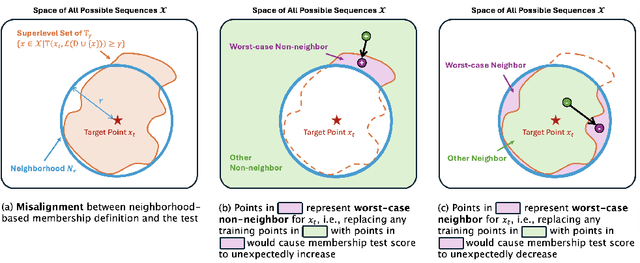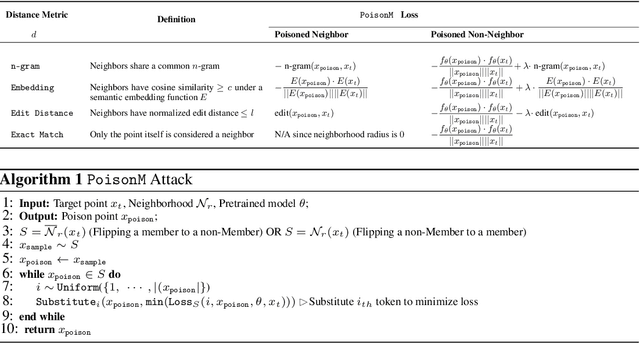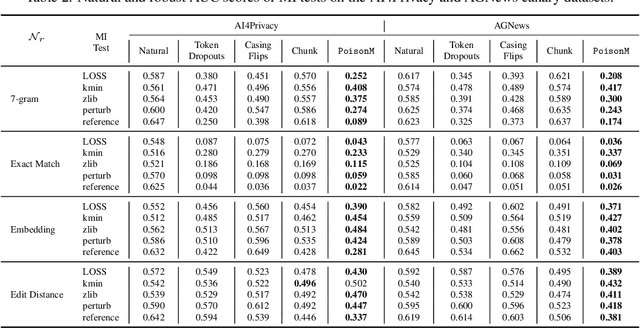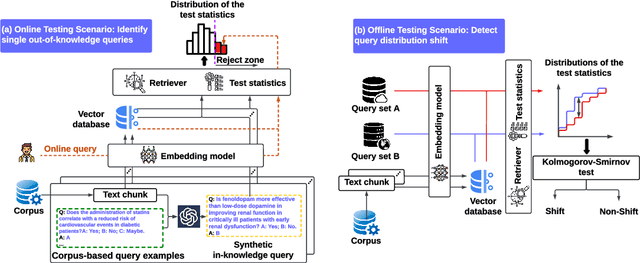Zhuohang Li
What Really is a Member? Discrediting Membership Inference via Poisoning
Jun 06, 2025



Abstract:Membership inference tests aim to determine whether a particular data point was included in a language model's training set. However, recent works have shown that such tests often fail under the strict definition of membership based on exact matching, and have suggested relaxing this definition to include semantic neighbors as members as well. In this work, we show that membership inference tests are still unreliable under this relaxation - it is possible to poison the training dataset in a way that causes the test to produce incorrect predictions for a target point. We theoretically reveal a trade-off between a test's accuracy and its robustness to poisoning. We also present a concrete instantiation of this poisoning attack and empirically validate its effectiveness. Our results show that it can degrade the performance of existing tests to well below random.
Can Large Language Models Help Multimodal Language Analysis? MMLA: A Comprehensive Benchmark
Apr 24, 2025Abstract:Multimodal language analysis is a rapidly evolving field that leverages multiple modalities to enhance the understanding of high-level semantics underlying human conversational utterances. Despite its significance, little research has investigated the capability of multimodal large language models (MLLMs) to comprehend cognitive-level semantics. In this paper, we introduce MMLA, a comprehensive benchmark specifically designed to address this gap. MMLA comprises over 61K multimodal utterances drawn from both staged and real-world scenarios, covering six core dimensions of multimodal semantics: intent, emotion, dialogue act, sentiment, speaking style, and communication behavior. We evaluate eight mainstream branches of LLMs and MLLMs using three methods: zero-shot inference, supervised fine-tuning, and instruction tuning. Extensive experiments reveal that even fine-tuned models achieve only about 60%~70% accuracy, underscoring the limitations of current MLLMs in understanding complex human language. We believe that MMLA will serve as a solid foundation for exploring the potential of large language models in multimodal language analysis and provide valuable resources to advance this field. The datasets and code are open-sourced at https://github.com/thuiar/MMLA.
SCE: Scalable Consistency Ensembles Make Blackbox Large Language Model Generation More Reliable
Mar 13, 2025Abstract:Large language models (LLMs) have demonstrated remarkable performance, yet their diverse strengths and weaknesses prevent any single LLM from achieving dominance across all tasks. Ensembling multiple LLMs is a promising approach to generate reliable responses but conventional ensembling frameworks suffer from high computational overheads. This work introduces Scalable Consistency Ensemble (SCE), an efficient framework for ensembling LLMs by prompting consistent outputs. The SCE framework systematically evaluates and integrates outputs to produce a cohesive result through two core components: SCE-CHECK, a mechanism that gauges the consistency between response pairs via semantic equivalence; and SCE-FUSION, which adeptly merges the highest-ranked consistent responses from SCE-CHECK, to optimize collective strengths and mitigating potential weaknesses. To improve the scalability with multiple inference queries, we further propose ``{You Only Prompt Once}'' (YOPO), a novel technique that reduces the inference complexity of pairwise comparison from quadratic to constant time. We perform extensive empirical evaluations on diverse benchmark datasets to demonstrate \methodName's effectiveness. Notably, the \saccheckcomponent outperforms conventional baselines with enhanced performance and a significant reduction in computational overhead.
Towards Statistical Factuality Guarantee for Large Vision-Language Models
Feb 27, 2025Abstract:Advancements in Large Vision-Language Models (LVLMs) have demonstrated promising performance in a variety of vision-language tasks involving image-conditioned free-form text generation. However, growing concerns about hallucinations in LVLMs, where the generated text is inconsistent with the visual context, are becoming a major impediment to deploying these models in applications that demand guaranteed reliability. In this paper, we introduce a framework to address this challenge, ConfLVLM, which is grounded on conformal prediction to achieve finite-sample distribution-free statistical guarantees on the factuality of LVLM output. This framework treats an LVLM as a hypothesis generator, where each generated text detail (or claim) is considered an individual hypothesis. It then applies a statistical hypothesis testing procedure to verify each claim using efficient heuristic uncertainty measures to filter out unreliable claims before returning any responses to users. We conduct extensive experiments covering three representative application domains, including general scene understanding, medical radiology report generation, and document understanding. Remarkably, ConfLVLM reduces the error rate of claims generated by LLaVa-1.5 for scene descriptions from 87.8\% to 10.0\% by filtering out erroneous claims with a 95.3\% true positive rate. Our results further demonstrate that ConfLVLM is highly flexible, and can be applied to any black-box LVLMs paired with any uncertainty measure for any image-conditioned free-form text generation task while providing a rigorous guarantee on controlling the risk of hallucination.
Automatic Prompt Optimization via Heuristic Search: A Survey
Feb 26, 2025Abstract:Recent advances in Large Language Models have led to remarkable achievements across a variety of Natural Language Processing tasks, making prompt engineering increasingly central to guiding model outputs. While manual methods can be effective, they typically rely on intuition and do not automatically refine prompts over time. In contrast, automatic prompt optimization employing heuristic-based search algorithms can systematically explore and improve prompts with minimal human oversight. This survey proposes a comprehensive taxonomy of these methods, categorizing them by where optimization occurs, what is optimized, what criteria drive the optimization, which operators generate new prompts, and which iterative search algorithms are applied. We further highlight specialized datasets and tools that support and accelerate automated prompt refinement. We conclude by discussing key open challenges pointing toward future opportunities for more robust and versatile LLM applications.
Do You Know What You Are Talking About? Characterizing Query-Knowledge Relevance For Reliable Retrieval Augmented Generation
Oct 10, 2024



Abstract:Language models (LMs) are known to suffer from hallucinations and misinformation. Retrieval augmented generation (RAG) that retrieves verifiable information from an external knowledge corpus to complement the parametric knowledge in LMs provides a tangible solution to these problems. However, the generation quality of RAG is highly dependent on the relevance between a user's query and the retrieved documents. Inaccurate responses may be generated when the query is outside of the scope of knowledge represented in the external knowledge corpus or if the information in the corpus is out-of-date. In this work, we establish a statistical framework that assesses how well a query can be answered by an RAG system by capturing the relevance of knowledge. We introduce an online testing procedure that employs goodness-of-fit (GoF) tests to inspect the relevance of each user query to detect out-of-knowledge queries with low knowledge relevance. Additionally, we develop an offline testing framework that examines a collection of user queries, aiming to detect significant shifts in the query distribution which indicates the knowledge corpus is no longer sufficiently capable of supporting the interests of the users. We demonstrate the capabilities of these strategies through a systematic evaluation on eight question-answering (QA) datasets, the results of which indicate that the new testing framework is an efficient solution to enhance the reliability of existing RAG systems.
Exploring User-level Gradient Inversion with a Diffusion Prior
Sep 11, 2024



Abstract:We explore user-level gradient inversion as a new attack surface in distributed learning. We first investigate existing attacks on their ability to make inferences about private information beyond training data reconstruction. Motivated by the low reconstruction quality of existing methods, we propose a novel gradient inversion attack that applies a denoising diffusion model as a strong image prior in order to enhance recovery in the large batch setting. Unlike traditional attacks, which aim to reconstruct individual samples and suffer at large batch and image sizes, our approach instead aims to recover a representative image that captures the sensitive shared semantic information corresponding to the underlying user. Our experiments with face images demonstrate the ability of our methods to recover realistic facial images along with private user attributes.
Analyzing Inference Privacy Risks Through Gradients in Machine Learning
Aug 29, 2024



Abstract:In distributed learning settings, models are iteratively updated with shared gradients computed from potentially sensitive user data. While previous work has studied various privacy risks of sharing gradients, our paper aims to provide a systematic approach to analyze private information leakage from gradients. We present a unified game-based framework that encompasses a broad range of attacks including attribute, property, distributional, and user disclosures. We investigate how different uncertainties of the adversary affect their inferential power via extensive experiments on five datasets across various data modalities. Our results demonstrate the inefficacy of solely relying on data aggregation to achieve privacy against inference attacks in distributed learning. We further evaluate five types of defenses, namely, gradient pruning, signed gradient descent, adversarial perturbations, variational information bottleneck, and differential privacy, under both static and adaptive adversary settings. We provide an information-theoretic view for analyzing the effectiveness of these defenses against inference from gradients. Finally, we introduce a method for auditing attribute inference privacy, improving the empirical estimation of worst-case privacy through crafting adversarial canary records.
PhaseEvo: Towards Unified In-Context Prompt Optimization for Large Language Models
Feb 17, 2024



Abstract:Crafting an ideal prompt for Large Language Models (LLMs) is a challenging task that demands significant resources and expert human input. Existing work treats the optimization of prompt instruction and in-context learning examples as distinct problems, leading to sub-optimal prompt performance. This research addresses this limitation by establishing a unified in-context prompt optimization framework, which aims to achieve joint optimization of the prompt instruction and examples. However, formulating such optimization in the discrete and high-dimensional natural language space introduces challenges in terms of convergence and computational efficiency. To overcome these issues, we present PhaseEvo, an efficient automatic prompt optimization framework that combines the generative capability of LLMs with the global search proficiency of evolution algorithms. Our framework features a multi-phase design incorporating innovative LLM-based mutation operators to enhance search efficiency and accelerate convergence. We conduct an extensive evaluation of our approach across 35 benchmark tasks. The results demonstrate that PhaseEvo significantly outperforms the state-of-the-art baseline methods by a large margin whilst maintaining good efficiency.
Why Does Differential Privacy with Large Epsilon Defend Against Practical Membership Inference Attacks?
Feb 14, 2024



Abstract:For small privacy parameter $\epsilon$, $\epsilon$-differential privacy (DP) provides a strong worst-case guarantee that no membership inference attack (MIA) can succeed at determining whether a person's data was used to train a machine learning model. The guarantee of DP is worst-case because: a) it holds even if the attacker already knows the records of all but one person in the data set; and b) it holds uniformly over all data sets. In practical applications, such a worst-case guarantee may be overkill: practical attackers may lack exact knowledge of (nearly all of) the private data, and our data set might be easier to defend, in some sense, than the worst-case data set. Such considerations have motivated the industrial deployment of DP models with large privacy parameter (e.g. $\epsilon \geq 7$), and it has been observed empirically that DP with large $\epsilon$ can successfully defend against state-of-the-art MIAs. Existing DP theory cannot explain these empirical findings: e.g., the theoretical privacy guarantees of $\epsilon \geq 7$ are essentially vacuous. In this paper, we aim to close this gap between theory and practice and understand why a large DP parameter can prevent practical MIAs. To tackle this problem, we propose a new privacy notion called practical membership privacy (PMP). PMP models a practical attacker's uncertainty about the contents of the private data. The PMP parameter has a natural interpretation in terms of the success rate of a practical MIA on a given data set. We quantitatively analyze the PMP parameter of two fundamental DP mechanisms: the exponential mechanism and Gaussian mechanism. Our analysis reveals that a large DP parameter often translates into a much smaller PMP parameter, which guarantees strong privacy against practical MIAs. Using our findings, we offer principled guidance for practitioners in choosing the DP parameter.
 Add to Chrome
Add to Chrome Add to Firefox
Add to Firefox Add to Edge
Add to Edge